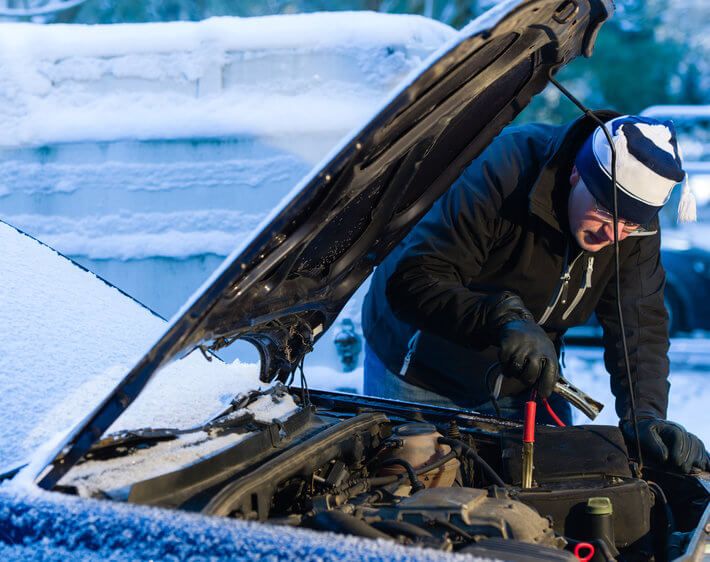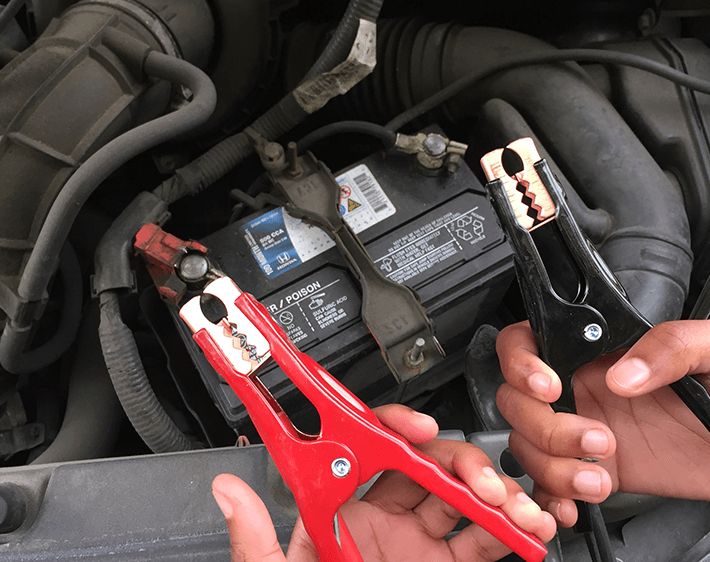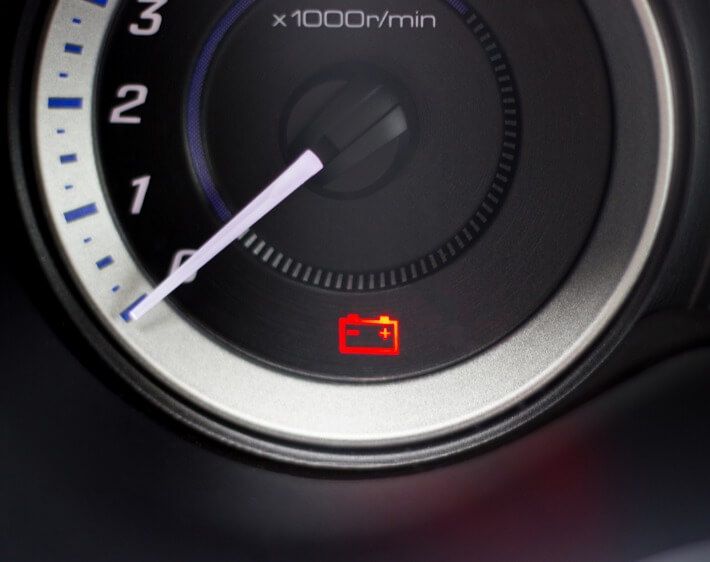
Why Car Batteries Die in Winter
Stumped about your car battery life in cold weather? Get the answers you need from Firestone Complete Auto Care to get through the winter season strong.
Read More
Wondering about car battery types and which is right for your vehicle? You've come to the right place. It pays to know the basics of batteries so you can ensure the expert care of your car.
When you need a new car battery, come into a Firestone Complete Auto Care in your neighborhood. We'll install the best battery choice from our selection of car battery types made by the industry's top car battery manufacturer. We'll size up your vehicle's OEM battery and electrical system, and then set up the proper car battery group size to power your ride. Learn more about car battery types, group sizes and other specifications that matter when selecting a car battery.
What type of car battery is right for your vehicle? Firestone Complete Auto Care is here with the answer. Learn more about the two basic battery types below, wet cell and VRLA batteries, then bring your vehicle to a local Firestone Complete Auto Care and let us install the best battery choice. Our technicians will evaluate your vehicle’s battery and electrical system and help you select the proper car battery group size to power your ride. Read on to learn more about car battery types, group sizes, and other specifications when selecting a car battery.
Wet cell batteries (flooded batteries) are lead acid batteries that are specifically designed for automotive use. It is the original rechargeable battery and contains a liquid electrolyte. Some lead-acid batteries require maintenance, as the water in the diluted acid can evaporate and may need to be topped off from time to time to maintain the specific ratio of water to acid. (Note, if you refill the water at home, do not use tap water. Use distilled water.) Some modern wet cell batteries use a semi-solid electrolyte (sometimes referred to as a “sealed battery”) which do not require maintenance.
There are two popular types of wet cell batteries, SLI batteries and deep cycle batteries.
SLI Battery: SLI stands for starting, lighting, and ignition. SLI batteries are designed to start your car with fast, short bursts of energy that power the motor, the lights, and the vehicle’s engine. Once the engine is running, power for the car is supplied by the alternator. Most automobiles come with a generic SLI battery from the factory.
Deep Cycle Battery: Deep cycle batteries, also referred to as marine batteries, last longer than SLI batteries and are designed for long-term energy delivery. They are designed to be deeply discharged over and over again (which would ruin an SLI battery), and can provide a steady amount of current over a long period of time.
A VRLA battery, or valve-regulated lead-acid battery, is a sealed battery with no venting of gases. These batteries are ideal for use in small spaces with no ventilation and since they’re sealed, they can be easily stored. VRLA batteries don’t leak or release hydrogen gas and are considered the safest wet cell lead-acid battery. The only drawback to VRLA batteries is that they’re sealed, leaving them unserviceable.
There are two types of VRLA batteries, the gel cell battery and the AGM battery.
Gel Cell Battery: Instead of containing a liquid electrolyte like a wet cell battery, a gel cell battery contains a “gelified” electrolyte. Gel batteries are tough. They’re extremely resistant to hot temperatures, spillage, physical shock, and electrolyte evaporation. Gel batteries function just like wet cell batteries, except they’re sealed and dry.
Absorbed Glass Mat Battery: An absorbed glass mat battery (AGM battery) is designed with the electrolyte held in glass mats, as opposed to freely flooding the plates. These glass mats are very thin fibers in the battery and are meshed together to form the electrolyte absorbed glass mat. AGM batteries work just like wet cell batteries, without the potential for spilled battery acid.
A battery group size is an industry-standard for car batteries that indicates the actual, physical size for a car battery (height x width x length), as well as the polarity (where the positive and negative battery posts are located on the battery). This makes it easy for vehicle manufacturers to take the battery size into consideration when designing a car, truck, or SUV.
Battery group sizes provide a simplified, industry standard in automotive batteries, helping manufacturers of batteries and vehicles both reduce costs. Having standard battery group sizes makes replacing your battery at your local Firestone Complete Auto Care simple, and our technicians and automotive advisors can ensure the proper battery fitment for just about any vehicle on the road.
Helpful Hint: Instead of trying to measure the exact size of your car battery with a tape measure, look for the "Group Size" printed on the label of the battery or check your owner’s manual. You can also call or visit any local Firestone Complete Auto Care location to verify your vehicle's correct battery replacement with the vehicle year, make, and model.
Certain vehicle manufacturers tend to use specific group sizes more than others. For example, many General Motors vehicles use (and/or used) a side-post battery. Side post batteries have cable ends that screw into the side of the battery, as opposed to having battery posts on the top of the battery. These group sizes are typically 70, 74, 75 and 78.
European vehicle manufacturers (Volkswagen, Audi, Mercedes Benz, BMW, etc.) typically use an "international" style of battery where the top posts are recessed in the corners so that the top of the battery posts are about equivalent to the main height of the battery. Many of these battery group size fitments have a specialized ventilation system as part of the battery, and some are also installed in the trunk or even under the back seat (as opposed to the typical placement under the hood). These group sizes are typically 41, 42, 47, 48 and 49.
Helpful Hint: The installation process of recessed top post batteries is often more difficult than other batteries. While the installation rates may be a little more for these battery group sizes, it may be very well be worth it to trust it to the expertise of Firestone Complete Auto Care's certified technicians. Call or drop by your local Firestone Complete Auto Care store for more details.
Japanese vehicles, many imports, and most American-made vehicles typically use a group size with standard, top-post battery fitments. These are the most-common battery group sizes that most people are used to seeing. While these are more common and seem easier to replace, it is still important to use the proper group size so that your car battery stays secure in your vehicle's battery tray.
For example, some group sizes are the same width and length, but have a lower height. If a taller battery is mistaken for a shorter group size, it may not fit properly in the battery tray and/or battery hold-down, or the battery post could even make contact with the metal hood of the vehicle, causing a spark, a short, or a vehicle fire. Again, as a precaution, consult with your Firestone Complete Auto Care technician for the proper battery fitment for your specific vehicle year, make, and model. In general, these more-common battery group sizes are 24, 24F, 25, 34, 35, 51, 51R, 52, 58, 58R, 59, and 65.
Helpful Hint: Some vehicles can handle a larger battery than was originally installed. A physically larger battery usually has more power and reserve time than a smaller battery. See if a larger battery is available for your vehicle.

Stumped about your car battery life in cold weather? Get the answers you need from Firestone Complete Auto Care to get through the winter season strong.

Reviving your car battery doesn't need to be filled with sparks and stress. Here's how to jump a car with jumper cables—with or without another vehicle.

Why is your battery light on? What can you do about it? Firestone Complete Auto Care has the answers you want, plus some DIY car battery troubleshooting tips.